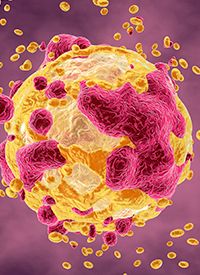News
Article
Nimotuzumab With Concurrent Chemoradiotherapy Shows Activity in Cervical Squamous Cell Carcinoma
Author(s):
Nimotuzumab given concurrently with chemoradiotherapy demonstrated efficacy and favorable tolerability in patients with locally advanced cervical squamous cell carcinoma, according to data from a randomized, controlled, open-label, multicenter study.

Nimotuzumab given concurrently with chemoradiotherapy (CCRT) demonstrated efficacy and favorable tolerability in patients with locally advanced cervical squamous cell carcinoma, according to data from a randomized, controlled, open-label, multicenter study (NCT04678791).1
The findings, which were shared in a poster during the 2023 ESMO Congress, indicated that the objective response rate (ORR) was 86.39% with nimotuzumab plus CCRT (n = 147) vs 76.39% with CCRT (n = 144; P = .028).
Among those who responded to the nimotuzumab regimen, 67.35% achieved a complete response, 19.05% had a partial response, and 4.08% experienced disease progression; 9.52% of patients were not response evaluable. In the CCRT-only group, these rates were 64.58%, 17.36%, 6.25%, and 11.81%, respectively.
“Nimotuzumab combined with concurrent chemoradiotherapy showed [a] longer survival trend and significantly improved the ORR in patients [with] locally advanced cervical squamous cell carcinoma with a good tolerance,” Ping Jiang, PhD, of the Department of Radiation Oncology in Peking University Third Hospital in Beijing, China, and colleagues, wrote in the poster.
The standard treatment for patients with locally advanced cervical cancer is concurrent chemoradiotherapy but 30% will recur and develop metastasis. Previous data have indicated that nimotuzumab paired with CCRT has antitumor activity and acceptable safety in this population.
The randomized, controlled, open-label, multicenter study enrolled a total of 291 patients with locally advanced cervical squamous cell carcinoma who were between the ages of 18 and 75 years and who had at least 1 measurable lesion by RECIST v1.1 criteria. To participate, they needed to have an ECOG performance status of 0 to 2, a life expectancy of at least 3 months, and acceptable organ function.
Study participants (n = 291) were randomly assigned 1:1 to receive nimotuzumab at 400 mg intravenously weekly for 6 weeks plus CCRT in the form of cisplatin at 40 mg/m2 weekly for 6 weeks and intensity-modulated radiation therapy/volumetric modulated arc therapy at 45 Gy to 50.4 Gy or 25 f to 28 f or high-dose rate brachytherapy at 30 Gy to 40 Gy (n = 147) or CCRT alone (n = 144).
The primary end point was 3-year progression-free survival (PFS) rate and secondary end points included 3-year overall survival (OS) rate, ORR, complete response rate, and safety.
The median follow-up was 1.8 months. Of the total population, 74.23% of patients were younger than 65 years. More than half (69.07%) of patients had a tumor diameter that was at least 4 cm in diameter. Regarding FIGO disease stage, 1.37% had stage IB3 disease, 8.93% had stage IIA disease, 32.30% had stage IIB disease, 2.75% had stage IIIA disease, 13.06% had stage IIIB disease, 35.05% had stage IIIC1 disease, 4.12% had stage IIIC2 disease, and 2.41% had stage IVA disease.
Regarding safety, the most common grade 1 or 2 adverse effects across the arms were leukopenia (85.50%), anemia (65.43%), neutropenia (58.74%), thrombocytopenia (45.35%), and nausea (42.38%). No significant difference in incidence of grade 3 or higher AEs was noted between the arms (P > .05). The most common grade 3 or higher AEs included leukopenia (57.59%), decreased lymphocyte count (36.08%), neutropenia (28.48%), and anemia (18.99%).
Previously, when nimotuzumab was paired with gemcitabine, it resulted in improved OS and PFS compared with gemcitabine alone in patients with KRAS wild-type locally advanced or metastatic pancreatic cancer, according to data from the phase 3 NOTABLE trial (NCT02395016).2
The median OS was 10.9 months with the nimotuzumab regimen vs 8.5 months with gemcitabine alone (HR, 0.50; 95% CI, 0.06-0.94; P = .025). The 1-year OS rate was 43.6% and the 3-year OS rate was 13.9%; with gemcitabine alone, these rates were 26.8% and 2.7%, respectively. The median PFS in the nimotuzumab/gemcitabine arm was 4.2 months vs 3.6 months with gemcitabine alone (HR, 0.56; 95% CI, 0.12-0.99; P = .013).
References
- Wang K, Jiang P, Wei L, et al. 759P nimotuzumab combined with concurrent chemo-radiotherapy in patients with locally advanced cervical squamous cell carcinoma: a randomized, controlled, open-label, multicenter study. Ann Oncol. 2023;34(suppl 2):S518-S519. doi:10.1016/j.annonc.2023.09.1938
- Qin S, Bai Y, Wang Z, et al. Nimotuzumab combined with gemcitabine versus gemcitabine in KRAS wild‐type locally advanced or metastatic pancreatic cancer: A prospective, randomized‐controlled, double‐blinded, multicenter, and phase III clinical trial. J Clin Oncol. 2022;40(suppl 17):LBA4011. doi:10.1200/JCO.2022.40.17_suppl.LBA4011









